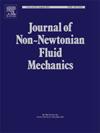Significance of viscous dissipation effect during the rapid filling process in the non-adiabatic mold: A full analytical and validating solution
IF 2.7
2区 工程技术
Q2 MECHANICS
引用次数: 0
Abstract
The thorough analysis of thermal effects in the interior of molds enhances the understanding of the role and evolution of flow-thermal interactions during injection molding. However, current methods that incorporate heating and insulation devices for detecting melt within molds do not accurately reflect actual manufacturing environments. The non-isothermal conditions in molds also complicate the quantitative analysis of thermal effects, posing challenges for in-mold analysis. In this study, we proposed a comprehensive analytical and validation approach to investigate the significance of viscous dissipation in a non-adiabatic mold during injection molding. Channel dimensions (fixed length of 25 mm, radii of 0.75–1.5 mm) and melt velocities (25–150 mm s−1) were adjusted to observe pressure drop variations () in a special-designed mold. An equivalent pressure concept () was proposed to assess temperature variations induced by viscous dissipation. Dimensionless indices related to channel dimensions ( and ) and melt injection velocities ( and ) were established to observe pressure drop () and corrected pressure drop (). The results indicate that the corrected pressure drop and viscosity curves ( and ) show more consistent variations versus channel dimensions and melt velocities when the viscous dissipation effect is quantitatively incorporated into melt pressure and viscosity analyses ( and ), aligning closely with observations under adiabatic conditions. Thermal-related dimensionless numbers (Eckert, Brinkman, and Peclet numbers) qualitatively confirm the significance of viscous dissipation. This study offers a comprehensive analysis and validation of thermal effects in mold, presenting a novel method for exploring specific melt behaviors and advancing the analysis of mold interiors in non-adiabatic environments.
非绝热模具快速充型过程中粘滞耗散效应的意义:一个完整的解析和验证解
对模具内部热效应的深入分析提高了对注射成型过程中流动-热相互作用的作用和演变的理解。然而,目前用于检测模具内熔体的加热和绝缘装置的方法并不能准确反映实际的制造环境。模具内的非等温条件也使热效应的定量分析复杂化,对模内分析提出了挑战。在这项研究中,我们提出了一种综合的分析和验证方法来研究注射成型过程中非绝热模具中粘性耗散的意义。在特殊设计的模具中,调整通道尺寸(固定长度为25mm,半径为0.75-1.5 mm)和熔化速度(25 - 150mm s−1)以观察压降变化(ΔPen)。提出了一个等效压力概念(ΔPvis)来评估粘性耗散引起的温度变化。建立与通道尺寸(IP_R和IPcor_R)和熔体喷射速度(IP_v和IPcor_v)相关的无量纲指标,观察压降(ΔPen)和修正压降(ΔPcor)。结果表明,当将粘性耗散效应定量地计入熔体压力和粘度分析(ΔPen和η)时,修正后的压降和粘度曲线(ΔPcor和ηcor)与通道尺寸和熔体速度的变化更为一致,与绝热条件下的观测结果非常吻合。热相关的无量纲数(Eckert, Brinkman和Peclet数)定性地证实了粘性耗散的重要性。本研究对模具内的热效应进行了全面的分析和验证,提出了一种探索特定熔体行为的新方法,并推进了非绝热环境下模具内部的分析。
本文章由计算机程序翻译,如有差异,请以英文原文为准。
求助全文
约1分钟内获得全文
求助全文
来源期刊
CiteScore
5.00
自引率
19.40%
发文量
109
审稿时长
61 days
期刊介绍:
The Journal of Non-Newtonian Fluid Mechanics publishes research on flowing soft matter systems. Submissions in all areas of flowing complex fluids are welcomed, including polymer melts and solutions, suspensions, colloids, surfactant solutions, biological fluids, gels, liquid crystals and granular materials. Flow problems relevant to microfluidics, lab-on-a-chip, nanofluidics, biological flows, geophysical flows, industrial processes and other applications are of interest.
Subjects considered suitable for the journal include the following (not necessarily in order of importance):
Theoretical, computational and experimental studies of naturally or technologically relevant flow problems where the non-Newtonian nature of the fluid is important in determining the character of the flow. We seek in particular studies that lend mechanistic insight into flow behavior in complex fluids or highlight flow phenomena unique to complex fluids. Examples include
Instabilities, unsteady and turbulent or chaotic flow characteristics in non-Newtonian fluids,
Multiphase flows involving complex fluids,
Problems involving transport phenomena such as heat and mass transfer and mixing, to the extent that the non-Newtonian flow behavior is central to the transport phenomena,
Novel flow situations that suggest the need for further theoretical study,
Practical situations of flow that are in need of systematic theoretical and experimental research. Such issues and developments commonly arise, for example, in the polymer processing, petroleum, pharmaceutical, biomedical and consumer product industries.

 求助内容:
求助内容: 应助结果提醒方式:
应助结果提醒方式:


